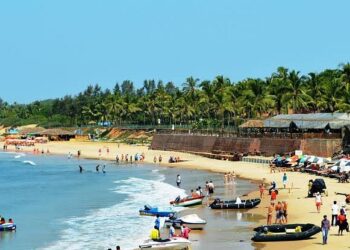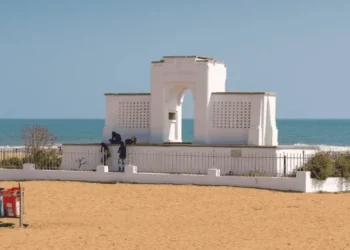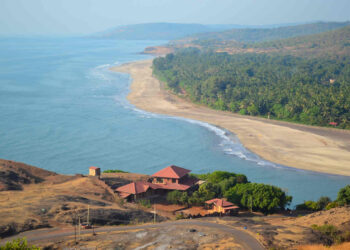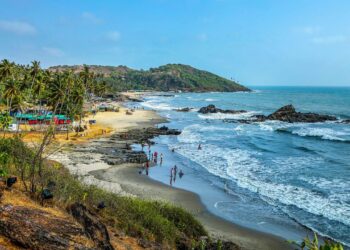Located in the old town of Khajuraho, Madhya Pradesh, the Kandariya Mahadeva Temple is a sacred shrine dedicated to Lord Shiva and is known for its fine stone carvings. Built around the 11th century, it is the largest and most ornate Hindu temple in the medieval temple group found at Khajuraho in Madhya Pradesh, India. Kandāriyā, meaning “the Great God of the Cave”, it is considered as one of the best examples of temples preserved from the medieval period in India.
Notable Fact: The temple’s 900 stone carvings, some making love, make it a UNESCO World Heritage site.
Mythological Significance
Kandariya Mahadeva carries old stories. One tale says King Chandravarman, a Chandela lord, raised it after Shiva came in a dream, blessing his kin. Another tells of Shiva as a sage, teaching wise men here, leaving his linga as a sign. Folks say prayers bring might and calm. The temple’s tie to Shiva links it to his great dance, standing proud among Khajuraho’s shrines. “Kandariya” means “Shiva’s cave,” pointing to his mystic ways.
Historical Background
Khajuraho was once the capital of the Chandela dynasty. The Kandariya Mahadeva Temple, one of the best examples of temples preserved from the medieval period in India, is the largest of the western group of temples in the Khajuraho complex which was built by the Chandela rulers. Shiva is the chief deity in the temple deified in the sanctum sanctorum. The Kandariya Mahadeva temple was built during the reign of Vidyadhara (r. c. 1003-1035 CE). At various periods of the reign of this dynasty many famous temples dedicated to Vishnu, Shiva, Surya, Shakti of the Hindu religion and also for the Thirthankaras of Jain religion were built. Vidhyadhara, also known as Bida in the recordings of the Muslim historian Ibn-al-Athir was a powerful ruler who fought Mahmud of Ghazni in the first offensive launched by the latter in 1019. This battle was not conclusive and Mahmud had to return to Ghazni.
Mahmud again waged war against Vidhyadhara in 1022. He attacked the fort of Kalinjar. The siege of the fort was unsuccessful. It was lifted and Mahmud and Vidhyadhara called a truce and parted by exchanging gifts. Vidhyadhara celebrated his success over Mahmud and other rulers by building the Kaṇḍāriyā Mahādeva Temple, dedicated to his family deity Shiva. Epigraphic inscriptions on a pilaster of the mandapa in the temple mentions the name of the builder of the temple as Virimda, which is interpreted as the pseudonym of Vidhyadhara. Its construction is dated to the period between 1025 and 1050 CE.All the extant temples in Khajuraho including the Kandariya Mahadeva Temple were inscribed in 1986 under the UNESCO List of World Heritage Sites under Criterion III for its artistic creation and under Criterion V for the culture of the Chandelas that was dominant until the country was invaded by Muslims in 1202.
Architecture of Kandariya Mahadeva Temple
Kandariya Mahadeva Temple sits on a big patch in Khajuraho’s Western Group, made in Nagara style. The main shrine has a tall top, 31 meters high, carved with gods, dancers, and lovers, all in yellow stone. Inside, the Shiva linga, black and smooth, rests in a dark room, lit by ghee lamps. The inner walls got plain stone with old prayer words.
The Kandariya Mahadeva Temple, 31 metres (102 ft) in height, is in the western complex, which is the largest among the three groups of the Khajuraho complex of temples. This western group of temples, consisting of the Kandariya, Matangeshwara and Vishvanatha temples, is compared to a “cosmic design of a hexagon (a yantra or Cosmo gram)” representing the three forms of Shiva. The temple architecture is an assemblage of porches and towers which terminates in a shikhara or spire, a feature which was common from the 10th century onwards in the temples of Central India.
The exterior surfaces of the temples are entirely covered with sculptures in three vertical layers. Here, there are horizontal ribbons carved with images, which shine bright in the sun light, providing rhythmic architectural features. Among the images of gods and heavenly beings, Agni, the god of fire is prominent. They are niches where erotic sculptures are fitted all round which are a major attraction among visitors. Some of these erotic sculptures are very finely carved and are in mithuna (coitus) postures with maidens flanking the couple, which is a frequently noted motif.
Information for Travelers
Hours and Entry: Open every day, 7:00 AM to 6:00 PM. Entry costs ₹30 for locals, ₹500 for foreigners. No pictures in the inner room.
How to Get There:
Air: Khajuraho Airport, 5 km off, is closest. Taxis take 15 minutes, cost ₹200–400.
Train: Khajuraho Station, 3 km away, links to Delhi (12 hours). Autos cost ₹50–100.
Road: Buses from Jhansi (5 hours) reach Khajuraho. Taxis cost ₹2000–3000. Roads are calm.
Best Time to Visit: October to March is cool, 20–30°C. Weekdays are quiet. Maha Shivratri’s full, so plan early.
Nearby Attractions:
Lakshmana Temple, 1 km away, is a Vishnu shrine.
Matangeshwar Temple, 1 km away, has a tall linga.
Parsvanath Temple, 2 km away, is a Jain shrine.
Chaturbhuj Temple, 3 km away, honors Vishnu.
Devi Jagdamba Temple, 1 km away, is a Devi shrine.
Final Thoughts
Kandariya Mahadeva Temple in Khajuraho, Madhya Pradesh, a sacred place in India’s heart, is a treasure for the soul. Lord Shiva’s great touch reaches all who visit, making it a spot you must see among India’s holy places.











